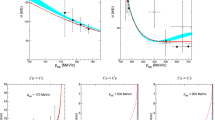Summary
In order to account for the selection rule λI= ± 1/2, which seems to govern the decays of hyperons and heavy mesons, the relevant interaction hamiltonian is taken as the component of a 1st kind spinor in isotopic space. Without any further hypothesis concerning the types of interaction and the number of independent hamiltonians this already provides some relations (see sect. 6) which could be tested by experiment and could also provide some information, especially on the spin and parity of the Σ. This is partly due to the fact that the scattering in the final state has some effect on the decay probabilities. A convenient mean for writing down explicitly such hamiltonians is also given. This leads to a discussion of the choice Fermi-typeversus Yukawa-type. No convincing argument can be given at the present stage for any of the two types. On the assumption of a Yukawa-type, chosen because of its greater simplicity, the consequences of some natural choices of the coupling constants are investigated.
Riassunto
Per giustificare la regola di selezioneλI ± 1/2 che sembra presiedere al decadimento degli iperoni e dei mesoni pesanti si prende la relativa hamiltoniana di interazione come la componente di uno spinore di prima specie nello spazio isotopico. Questo è sufficiente a fornire senza ulteriori ipotesi riguardo ai tipi di interazione e al numéro di hamiltoniane indipendenti, alcune relazioni (v. Sez. 6) suscettibili di essere saggiate sperimentalmente e di fornire anche elementi, specialmente sullo spin e la parità dei Σ. CiÒ è in parte dovuto al fatto che lo scattering nello stato finale influenza in una certa misura le probabilità di decadimento. Si dà anche un mezzo opportuno per scrivere le suddette hamiltoniane in forma esplicita. CiÒ porta alla discussione sulla scelta tipo Fermi-tipo Yukawa. Allo stato attuale delle cose non si possono portare argomenti convincenti a favore di uno dei due tipi. Scegliendo, a causa della sua maggior semplicità, un tipo Yukawa, si esaminano le conseguenze di alcune scelte naturali delle costanti di accoppiamento.
Similar content being viewed by others
References
M. Gell-Mann andA. Pais:Proceedings of Glasgow Conference on Nuclear and Meson Physics (1954), p. 342.
B. D’Espagnat etJ. Peentki:Phys. Rev.,99, 328 (1955);Compt. Rend.,240, 2486 (1955);CERN Report 55-11 (1955);Nuclear Physics,1, 33 (1956).
Gr. Racah:Nuclear Physics, sous presse.
Remarque de R. H. Dalitz citée parR. E. Marshak:Bull. Am. Phys. Soc.,30, No. 8, 25 (1955).
G. Wentzel:Phys. Rev., sous presse.
B. D’Espagnat etJ. Prentki:Compt. Rend.,242, 740 (1956).
K. M. Watson:Phys. Rev.,85, 852 (1952).
N. Dallaporta:Nuovo Cimento,1, 962 (1955).
M. Gell-Mann:Report at the Pisa Conference on Elementary Particles (1955), non publié.
G. F. Chew:Phys. Rev.,94, 1755 (1954).
M. Goldberger:Phys. Rev.,84, 929 (1951).
W. G. Holladat:Bull. Am. Phys. Soc., II,1, 51 (1956).
G. F. Chew:Phys. Rev.,89, 591 (1953).
Author information
Authors and Affiliations
Rights and permissions
About this article
Cite this article
d’Espagnat, B., Prentki, J. Interactions faibles des hypérons et des mésons lourds. Nuovo Cim 3, 1045–1059 (1956). https://doi.org/10.1007/BF02823502
Received:
Published:
Issue Date:
DOI: https://doi.org/10.1007/BF02823502




